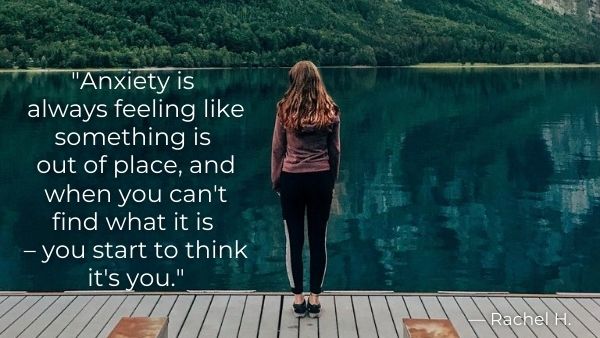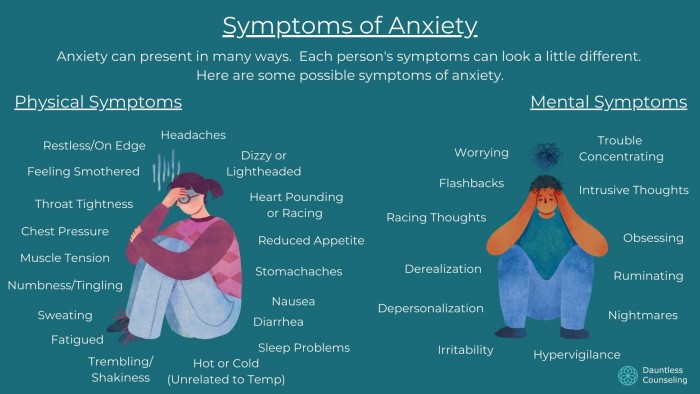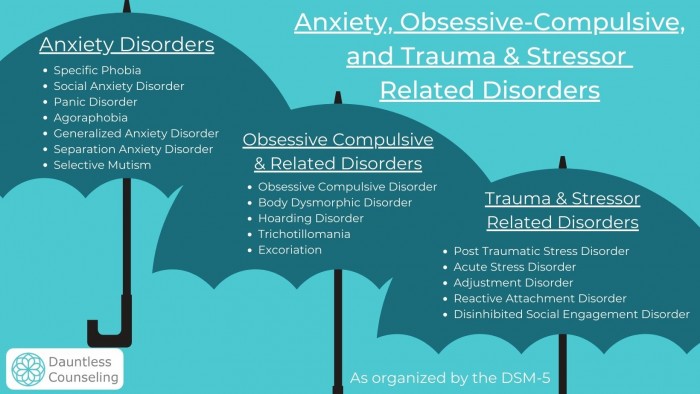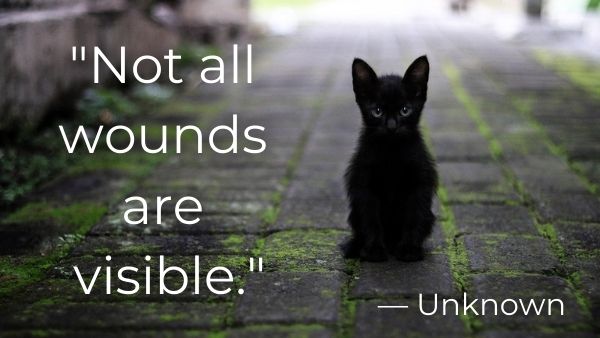You’re not sure exactly what’s wrong, but you know that recently things have been feeling “off.” Things that didn’t used to bother you are now hard to get off your mind. Things that used to be easy now feel super hard.
One day, you go in for a checkup with your doctor and decide, maybe reluctantly, to mention some of the things you’ve been struggling with recently. Maybe it feels awkward to talk about, or maybe it’s a relief. “It sounds like you have an anxiety disorder,” your doctor says.
But what does that mean?
The truth is, anxiety comes in many “flavors” as well as levels of seriousness. Keep reading if you’d like to know more.
Table of Contents
Healthy Anxiety
You might be thinking, “Healthy anxiety?! There’s no such thing!” But a small amount of anxiety is actually a totally normal, healthy human experience.
Low levels of anxiety can show us that something is important to us and give us the motivation to do something about the situation – such as study for an upcoming test or practice for an upcoming swim meet.
Anxiety (or fear) in response to something that is potentially dangerous can also be a healthy protective factor – so maybe we take the more well-lit main road instead of walking down a dark alley alone at night.
In these kinds of situations, anxiety is not hurting us, but helping us! And that’s why we have anxiety in the first place. It is our body’s way of trying to keep us safe.

Problem Anxiety
In some cases, however, your brain can start to have “false alarms.” In this case, the anxiety may be either in response to something that is not actually dangerous, or it may simply be out of proportion to the trigger.
So instead of studying for that test, you become preoccupied with worries about failing. Or instead of practicing for the swim meet, you start avoiding the pool altogether. Now your anxiety is causing problems, rather than helping them.
So how do you know if you have problem anxiety? I always say, “It’s only a problem if it’s a problem!” Which is a silly way of saying, if anxiety is getting in the way of being able to live your life, accomplish your goals, or enjoy yourself, then it’s most likely problem anxiety.
How You Experience Anxiety
You may experience anxiety as primarily physical symptoms in your body – everything from a racing heart to chest pressure to upset stomach to headaches. Or you may experience your anxiety as more mental – racing thoughts, difficulty focusing, ruminating, worrying, etc.

Lots of people experience their anxiety as some combination of the two, with their anxiety sometimes being more physical and other times more mental.
Anxiety Diagnoses
If you have found that anxiety is starting to get in the way of your life, you’re not alone. Just over 18% of the adult population in the US has an anxiety disorder, making anxiety disorders the most common type of mental illness in the United States.
When someone has anxiety that has gotten out of control, then they may be at the point where they could be diagnosed with an anxiety disorder.
One thing to know is that “anxiety” is not a diagnosis.
In the US, the Diagnostic and Statistical Manual of Mental Disorders, 5th Edition (or DSM-5) is used as the standard for diagnosing mental health problems. These are some of the main anxiety diagnoses found in the DSM-5 (although this is by no means an exhaustive list of all types of anxiety):
- Generalized Anxiety Disorder (GAD)
- Specific Phobia
- Social Anxiety Disorder (or Social Phobia)
- Panic Disorder
- Obsessive-Compulsive Disorder (OCD)
- Post-Traumatic Stress Disorder (PTSD)

The symptoms of the six most common anxiety diagnoses are described below, along with how common each diagnosis is among adults in the United States, per the Anxiety & Depression Association of America.
Generalized Anxiety Disorder (GAD)
Approximately 3.1% of the US population (or 6.8 million adults) have GAD. When diagnosing someone with GAD, health professionals look for the following symptoms:
- You often experience excessive worry or anxiety about a variety of topics (ex: school, work, your relationships, etc.)
- It is difficult for you to stop worrying
- You frequently experience at least 3 of these symptoms:
- Feeling restless or edgy
- Feeling tired easily
- Trouble concentrating
- Feeling irritable
- Tension in your muscles
- Sleep problems (having a hard time falling asleep, staying asleep, or getting quality sleep)
If you think you might have GAD, you can take a screening tool that you can share with your doctor or other health care provider.
Specific Phobia
Approximately 8.7% of US adults have at least one phobia (that’s 19 million people!). These are the symptoms of a specific phobia that health professionals will look for:
- You have significant anxiety triggered consistently by a specific object or situation (examples include heights, a specific animal or bug, tight spaces, flying, vomiting, needles, etc.)
- Your anxiety is excessive in comparison to the real risk posed by the object or circumstance
- You find yourself either purposefully avoiding your trigger or enduring your trigger with lots of anxiety
If you think you might have a phobia, here’s a screening tool you can check out and share with your doctor or other health care provider.
Social Anxiety Disorder (or Social Phobia)
Approximate 6.8% of US adults, or 15 million people, suffer from Social Anxiety Disorder (SAD). When someone may qualify for a diagnosis of SAD, these are the symptoms that a healthcare professional will look for:
- You have significant anxiety consistently triggered by social situations, especially if you feel you may be judged or embarrassed (examples include talking to a new person, being seen eating, giving a presentation, appearing anxious in front of others, etc.)
- Your anxiety is excessive in comparison to the real risk posed by the situation
- You find yourself either intentionally avoiding social situations or going through them with extreme anxiety
If you think you might have social anxiety, you can check out this screening tool that you can share with your doctor or other health care provider (please note that this will open as a document). You can also check out my article on social anxiety myths.

Panic Disorder
About 2.7% of adults (or 6 million people) in the US are affected by Panic Disorder. For a diagnosis of Panic Disorder, healthcare professionals look for the following symptoms:
- You experience at least one sudden, intense flood of anxiety (called a panic attack) that includes at least four of the following:
- Sweating
- Trembling or shakiness
- You feel numb or tingly
- You feel like you are choking
- Your heart pounds or speeds up
- You have chest pain or tightness
- You feel dizzy, faint, or lightheaded
- You feel nauseous or have an upset stomach
- You feel smothered or like you can’t catch your breath
- You feel hot or cold (unrelated to your environment)
- You feel like things around you aren’t real (called derealization) or like you are not yourself (called depersonalization)
- You feel like you are “going crazy” or could lose control
- You feel like you are dying
- After experiencing a panic attack, you worry about having another one or change how you live your life in order to avoid potentially panicking (examples include avoiding going certain places, engaging in certain activities, etc.)
If you think you might have Panic Disorder, here’s a screening tool that you can share with your doctor or other health care provider. You can also check out this article on how to survive a panic attack.
Obsessive-Compulsive Disorder (OCD)
About 1% of US adults suffer from OCD (2.2 million people). Unfortunately, OCD often goes unrecognized or misdiagnosed, especially since many symptoms of OCD can feel especially scary to talk about. Healthcare professionals will look for these symptoms to make a diagnosis:
- You must have obsessions, compulsions, or both
- Obsessions: Repetitive or constant thoughts, impulses, or images that are invasive, undesired, and cause anxiety
- Compulsions: Repetitive actions or mental acts that you feel like you must do in response to your obsessions (examples include washing your hands, praying, counting, checking, mentally reviewing, etc.)
- You attempt to ignore or get rid of your obsessions or “neutralize” them with compulsions
- Your compulsions are done to reduce your anxiety or prevent something unwanted from happening. However, they are either excessive or not logically connected to the desired outcome (for example, tapping your fingers to make sure you don’t get sick)
OCD can show up in lots of different ways. Check out my other article to read more about the types of OCD. If you are wondering if you have OCD, you can take this screening tool that you can share with your doctor or other health care provider.
Post-Traumatic Stress Disorder (PTSD)
Approximately 3.5% of US adult have PTSD (or 7.7 million people). For most anxiety disorders, there is a worry that something horrible will happen. PTSD is unique in that the anxiety is related to something terrible that already happened.
If you may have PTSD, these are the symptoms that a healthcare professional will look for to make a diagnosis:
- You were exposed to actual or threatened death, significant injury, or sexual violence (this could be personally, as a witness, as a close family member or friend, or in the line of duty)
- Your memories of the event or events affect you in one or more of the following ways:
- You have repeated, distressing memories that intrude on your day-to-day life
- You have repetitive, upsetting dreams (these may or may not be about the events themselves)
- You feel as if you are experiencing the event or events all over again (called flashbacks)
- You feel very anxious when anything reminds you of what happened (you may experience this anxiety as physical or mental symptoms)
- You try to avoid anything that may remind you of what happened (this can include related thoughts, feelings, people, places, activities, objects, etc.)
- Your mood or thinking is affected in at least two of the following ways:
- It’s hard for you to remember important parts of what happened
- You have constant negative thoughts about yourself, other people, or the world in general (for example: “I’m a bad person,” “I can’t trust anyone,” or “The world is a dangerous place.”)
- You blame yourself for what happened even though it was not your fault
- You often feel scared, angry, guilty, ashamed, or horrified
- You find it hard to feel happy, satisfied, or other positive emotions
- You feel less interested in things you used to enjoy
- You feel detached or distant from others
- You experience at least two of the following:
- You feel irritable or have angry outbursts
- You do things that are reckless or self-destructive
- You are on constant high alert (called hypervigilance)
- You startle easily at loud noises or things that surprise you
- You have trouble concentrating
- You have sleep problems (having a hard time falling asleep, staying asleep, or getting quality sleep)
If you think it’s possible you may have PTSD, here is a screening tool you can you share with your doctor or other health care provider.
| Name of Disorder | Anxiety Centers Around | Look For… | Minimum Length of Time |
| Generalized Anxiety Disorder (GAD) | Day-to Day Stressors (ex: work, school) | Uncontrollable worry | 6 months |
| Specific Phobia | A specific feared object, place, activity, etc. (ex: bugs, needles) | Anxiety that is disproportionate to trigger | 6 months |
| Social Anxiety Disorder (SAD) | Social interactions or possible judgement | Avoidance of new people or social situations | 6 months |
| Panic Disorder | Possibly having another panic attack | Extreme anxiety in short bursts | 1 month |
| Obsessive-Compulsive Disorder (OCD) | Many possible themes (ex: fear of harming others, symmetry, etc.) | A cycle of worrying and doing compulsions to neutralize worries | 6 months |
| Post-Traumatic Stress Disorder (PTSD) | A traumatic event that occurred | Nightmares, flashbacks, hypervigilance | 1 month |
For a diagnosis of Generalized Anxiety, Specific Phobias, or Social Anxiety your symptoms must have lasted for at least 6 months. For a diagnosis of PTSD or Panic Disorder, your symptoms must have lasted for at least 1 month.
In all cases, your symptoms must impact your life (at work, at school, in your relationships, etc.) negatively and significantly for you to qualify for a diagnosis. It’s also important to rule out any medical diagnoses or substances that could potentially be causing your symptoms.
Being Diagnosed
There are lots of reasons that someone may or may not want to be diagnosed with an anxiety disorder.
Possible Drawbacks of Getting a Diagnosis
For some, being diagnosed can feel scary or limiting. Having a label for what you’re dealing with may feel like being put in a box. You may wonder how all the pain and suffering that you are dealing with can possibly be covered by just a few words.
Or you may worry about the stigma or judgement that can come with having a diagnosis. Mental health may not be something that’s acknowledged as significant or feels okay to talk about in your house or your culture.
You may have gotten the message that mental health struggles are meant to be delt with privately at home, not talked about openly. And even telling those at home may not feel safe. There is often a message of “Just suck it up” or “Just get over it” that comes with the misunderstanding of how mental health works.
Possible Benefits of Getting a Diagnosis
For others, getting a diagnosis may lead to a sense of relief. Knowing what something is and being able to call it by a name can feel empowering and help you feel less alone. “I’m not the only one who feels like this! In fact, there are so many people who have felt this way that there’s a specific name for it.”
A diagnosis can also serve to help you get better. Once you know what something is called, you can look for someone who knows how to treat that thing!
It’s very common to have mixed feelings about being diagnosed with any disorder, including an anxiety diagnosis. Know that whatever you are feeling, you are not alone.

Ok, You Have a Diagnosis, Now What?
Once you know what you are dealing with, it can be easier to find resources to help yourself start to feel better.
Options for treating anxiety disorders include self-help resources, individual therapy, group therapy, medication, and other options. There are multiple routes you can take, and often a combination of approaches can be helpful.
| Self-Help | Individual Therapy |
| – Apps – Books – Podcasts – Changes to diet | – Exposure and Response Prevention – Acceptance and Commitment Therapy – Other evidence-based treatments |
| Group Therapy | Medication |
| – Peer support groups – Professional-led groups | – Consult a psychiatrist |
| Other | |
| – Yoga – Acupuncture – Transcranial Magnetic Stimulation (TMS) |
I recommend the “Find Help” tab on the International OCD Foundation website if you are looking for an anxiety specialist in your area or other anxiety-related resources. If you are looking for a free OCD Support group, you can check out the options on the NOCD website.
The good news is, anxiety disorders are very treatable. You don’t have to feel the way you’re feeling forever!
What questions do you have about anxiety disorders? Let me know in the comments below.
As a reminder, this blog post is not intended as professional counseling or clinical advice. This article is meant to provide individuals with a better understanding of anxiety disorders. I encourage you to consider seeking help in person if you need additional support or are feeling overwhelmed by your anxiety or OCD.

-Kristel Roper, LMFT, LPCC
Kristel Roper is a licensed psychotherapist offering therapy services to individuals in the Sacramento area. She specializes in anxiety counseling and especially enjoys working with young adults as they navigate the challenges of college, career, and beyond. Learn more about Kristel Roper’s Therapy Services.
Photo by Andreas Dress on Unsplash
Photo by Nariman Mesharrafa on Unsplash

My brother suggested I might like this web site. He was entirely right. This post truly made my day. You can not imagine just how much time I had spent for this information! Thanks!
Hey there, You’ve done a fantastic job. I?ll certainly digg it and personally suggest to my friends. I’m confident they will be benefited from this website.
I’ve been surfing on-line greater than three hours as of late, but I never found any fascinating article like yours. It is beautiful price enough for me. In my view, if all website owners and bloggers made excellent content as you probably did, the internet will be a lot more useful than ever before.
Heya i?m for the first time here. I came across this board and I find It really helpful & it helped me out much. I hope to provide one thing again and help others like you helped me.
Someone necessarily help to make significantly articles I might state.
This is the very first time I frequented your web page and to this point?
I surprised with the analysis you made to make this particular post
incredible. Wonderful task!